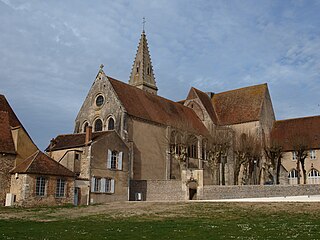
Crux is a constellation of the southern sky that is centred on four bright stars in a cross-shaped asterism commonly known as the Southern Cross. It lies on the southern end of the Milky Way's visible band. The name Crux is Latin for cross. Even though it is the smallest of all 88 modern constellations, Crux is among the most easily distinguished as its four main stars each have an apparent visual magnitude brighter than +2.8. It has attained a high level of cultural significance in many Southern Hemisphere states and nations.

Penicillins are a group of β-lactam antibiotics originally obtained from Penicillium moulds, principally P. chrysogenum and P. rubens. Most penicillins in clinical use are synthesised by P. chrysogenum using deep tank fermentation and then purified. A number of natural penicillins have been discovered, but only two purified compounds are in clinical use: penicillin G and penicillin V. Penicillins were among the first medications to be effective against many bacterial infections caused by staphylococci and streptococci. They are still widely used today for different bacterial infections, though many types of bacteria have developed resistance following extensive use.

Penicillium is a genus of ascomycetous fungi that is part of the mycobiome of many species and is of major importance in the natural environment, in food spoilage, and in food and drug production.

Acrux is the brightest star in the southern constellation of Crux. It has the Bayer designation α Crucis, which is Latinised to Alpha Crucis and abbreviated Alpha Cru or α Cru. With a combined visual magnitude of +0.76, it is the 13th-brightest star in the night sky. It is the most southerly star of the asterism known as the Southern Cross and is the southernmost first-magnitude star, 2.3 degrees more southerly than Alpha Centauri. This system is located at a distance of 321 light-years from the Sun.

Mimosa is the second-brightest object in the southern constellation of Crux, and the 20th-brightest star in the night sky. It has the Bayer designation β Crucis, which is Latinised to Beta Crucis and abbreviated Beta Cru or β Cru. Mimosa forms part of the prominent asterism called the Southern Cross. It is a binary star or a possible triple star system.

Blue cheese is any of a wide range of cheeses made with the addition of cultures of edible molds, which create blue-green spots or veins through the cheese. Blue cheeses vary in taste from very mild to strong, and from slightly sweet to salty or sharp; in colour from pale to dark; and in consistency from liquid or very soft to firm or hard. They may have a distinctive smell, either from the mold or from various specially cultivated bacteria such as Brevibacterium linens.

The Trichocomaceae are a family of fungi in the order Eurotiales. Taxa are saprobes with aggressive colonization strategies, adaptable to extreme environmental conditions. Family members are cosmopolitan in distribution, ubiquitous in soil, and common associates of decaying plant and food material.

Gacrux is the third-brightest star in the southern constellation of Crux, the Southern Cross. It has the Bayer designation Gamma Crucis, which is Latinised from γ Crucis and abbreviated Gamma Cru or γ Cru. With an apparent visual magnitude of +1.63, it is the 26th brightest star in the night sky. A line from the two "Pointers", Alpha Centauri through Beta Centauri, leads to within 1° north of this star. Using parallax measurements made during the Hipparcos mission, it is located at a distance of 88.6 light-years from the Sun. It is the nearest M-type red giant star to the Sun.

Penicillium roqueforti is a common saprotrophic fungus in the genus Penicillium. Widespread in nature, it can be isolated from soil, decaying organic matter, and plants.

Mevastatin is a hypolipidemic agent that belongs to the statins class.
The Servants of Jesus and Mary are a Roman Catholic congregation which was founded in 1988 by Andreas Hönisch, a former Jesuit, expelled by his congregation due to his traditional views of the Catholic doctrine and pedagogy.

Bouzonville is a commune in the Moselle department in Grand Est in northeastern France.

Paweł Łukaszewski is a Polish composer of choral music. He has won seven prestigious Fryderyk Awards. According to David Wordsworth, Łukaszewski is the best-known Polish composer of his generation in and out of Poland "by far".

Rosarium Virginis Mariae is an apostolic letter by Pope John Paul II, issued on October 16, 2002, which declared from October 2002 to October 2003 as the "Year of the Rosary". It was published by Pope John Paul II in 2002 at the beginning of the twenty-fifth year of his pontificate.

Valle Crucis Abbey is a Cistercian abbey located in Llantysilio in Denbighshire, Wales. More formally the Abbey Church of the Blessed Virgin Mary, Valle Crucis it is known in Welsh both as Abaty Glyn Egwestl and Abaty Glyn y Groes. The abbey was built in 1201 by Madog ap Gruffydd Maelor, Prince of Powys Fadog. Valle Crucis was dissolved in 1537 during the Dissolution of the Monasteries, and subsequently fell into serious disrepair. The building is now a ruin, though large parts of the original structure still survive. Valle Crucis Abbey is now under the care of Cadw. The abbey received 5,690 visitors in 2018.

Penicillium chrysogenum is a species of fungus in the genus Penicillium. It is common in temperate and subtropical regions and can be found on salted food products, but it is mostly found in indoor environments, especially in damp or water-damaged buildings. It has been recognised as a species complex that includes P. notatum, P. meleagrinum, and P. cyaneofulvum. Molecular phylogeny has established that Alexander Fleming's first discovered penicillin producing strain is of a distinct species, P. rubens, and not of P. notatum. It has rarely been reported as a cause of human disease. It is the source of several β-lactam antibiotics, most significantly penicillin. Other secondary metabolites of P. chrysogenum include roquefortine C, meleagrin, chrysogine, 6-MSA YWA1/melanin, andrastatin A, fungisporin, secalonic acids, sorbicillin, and PR-toxin.

Charles Thom was an American microbiologist and mycologist. Born and raised in Illinois, he received his PhD from the University of Missouri, the first such degree awarded by that institution. He studied the microbiology of dairy products and soil fungi, and in particular researched the genera Aspergillus and Penicillium. His work influenced the establishment of standards for food handling and processing in the USA. He pioneered the use of culture media to grow microorganisms, and, with food chemist James N. Currie, developed a process to mass-produce citric acid using Aspergillus. Thom played an important role in the development of penicillin in World War II.

The Notitia de servitio monasteriorum is a list of monasteries in the Frankish Empire and the services they owed the crown. It was compiled under Emperor Louis the Pious in 819, probably as a summation of the royal reform of the monasteries carried out following the councils of 816 and 817. It is not a complete list of the reformed monasteries: only 82 of the 104 monasteries known to have adopted the reforms are listed in the Notitia.















